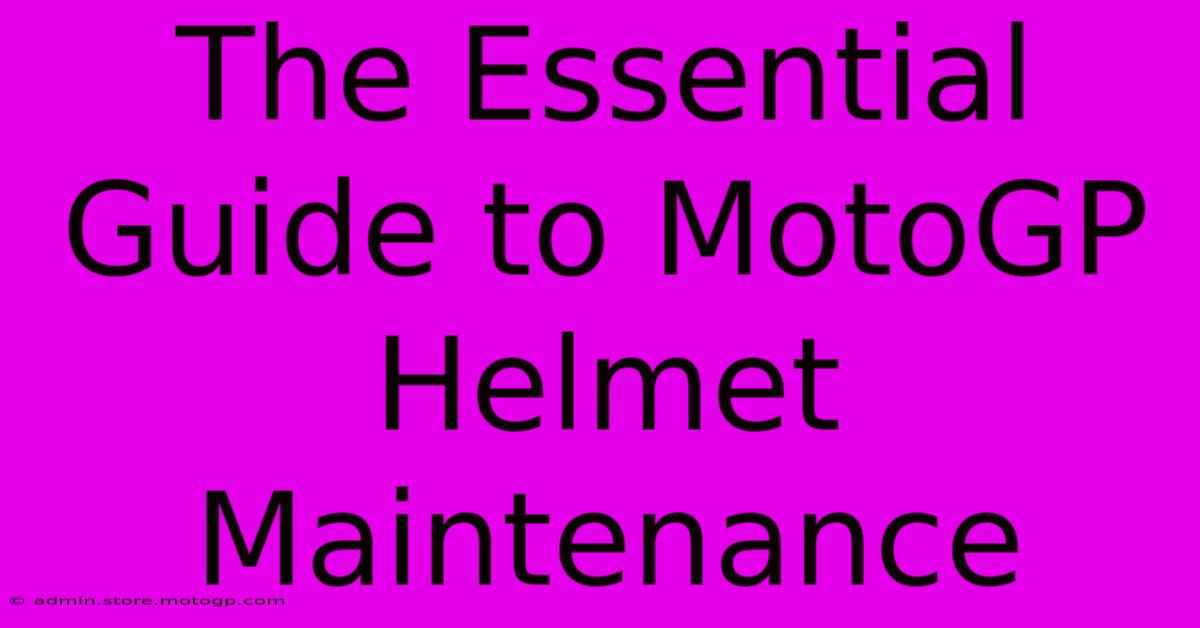The Essential Guide To MotoGP Helmet Maintenance

Table of Contents
The Essential Guide to MotoGP Helmet Maintenance
For MotoGP riders, the helmet isn't just safety equipment; it's a crucial extension of their performance and a vital shield against extreme speeds and potential impacts. Maintaining a MotoGP helmet isn't just about cleaning; it's about ensuring optimal safety and performance, extending its lifespan, and protecting your significant investment. This guide outlines essential maintenance practices to keep your helmet (or your replica!) in top condition.
Understanding Your MotoGP Helmet
Before diving into maintenance, it's crucial to understand the components of your helmet. A typical MotoGP-style helmet comprises:
- Outer Shell: Typically made from carbon fiber or a similar composite for maximum strength and minimal weight.
- Inner Liner: Usually removable and washable, offering comfort and crucial impact absorption.
- Visor: Provides protection from wind, debris, and sun glare. Different visors are optimized for various conditions.
- Straps & Buckles: Securely fasten the helmet to your head, needing regular inspection for wear and tear.
- Ventilation System: Essential for managing temperature and humidity inside the helmet.
Understanding these components will help you tailor your maintenance routine effectively.
Regular Cleaning and Care: Your Weekly Ritual
Cleaning the Outer Shell:
- Avoid harsh chemicals: Use mild soap and lukewarm water. Harsh chemicals can degrade the shell's protective layers.
- Gentle cleaning: Use a soft sponge or microfiber cloth to clean the outer shell, avoiding abrasive materials.
- Dry thoroughly: Always allow the shell to air dry completely before storing to prevent mold and mildew growth.
- Specific cleaning agents: Certain manufacturers recommend specific cleaners designed for the materials of their helmets. Always consult your helmet's manual for instructions.
Cleaning the Inner Liner:
- Frequent washing: Wash the inner liner regularly, ideally after each use, according to the manufacturer's instructions.
- Appropriate cleaning method: Some liners are machine washable, while others require hand washing. Always follow the manufacturer's instructions.
- Air drying: Ensure the liner is completely dry before reinstalling to prevent the growth of bacteria and fungi.
Visor Maintenance:
- Regular cleaning: Clean the visor after each use with a suitable cleaning solution.
- Anti-fog treatment: Apply an anti-fog treatment to prevent fogging, particularly in humid conditions. Avoid using harsh cleaning agents on the visor's optical properties.
- Scratch avoidance: Use a soft microfibre cloth for cleaning the visor to avoid scratches. Store your helmet appropriately to protect the visor from unwanted scratches.
Regular Inspection: A Monthly Check-up
Beyond cleaning, monthly inspections are crucial:
- Check the shell for cracks: Examine the outer shell carefully for any cracks, chips, or significant damage.
- Inspect the straps and buckles: Check for wear and tear, fraying, or any signs of damage. Replace worn straps immediately.
- Examine the visor mechanism: Ensure the visor mechanism functions smoothly and securely.
- Check the ventilation system: Ensure all vents are clean and functioning correctly.
- Assess the inner liner: Check the liner for any significant wear, tears, or degradation.
When to Replace Your Helmet: Recognizing the Warning Signs
Even with diligent maintenance, helmets have a limited lifespan. Replace your helmet if:
- Significant impact: The helmet has been involved in a significant impact, even if there's no visible damage. Internal damage may not be apparent.
- Extensive wear and tear: If the shell, straps, or liner shows significant wear and tear beyond what cleaning can resolve.
- Expiration date: Check for manufacturer recommendations for helmet replacement.
- Doubt: If you have any doubt about the helmet's structural integrity, replace it. Safety is paramount.
Storing Your MotoGP Helmet: Protecting Your Investment
Proper storage safeguards your helmet and maximizes its life:
- Cool and dry place: Store your helmet in a cool, dry place away from direct sunlight and extreme temperatures.
- Avoid contact with sharp objects: Protect the helmet from sharp objects that could damage the shell or visor.
- Helmet bag: Use a helmet bag for added protection and dust prevention during storage and transport.
Maintaining your MotoGP helmet is crucial for safety, performance, and longevity. By following this guide, you can extend the life of your helmet while ensuring it remains in optimal condition to provide the protection you need on the track. Remember, a well-maintained helmet is an investment in your safety and well-being.

Thank you for visiting our website wich cover about The Essential Guide To MotoGP Helmet Maintenance. We hope the information provided has been useful to you. Feel free to contact us if you have any questions or need further assistance. See you next time and dont miss to bookmark.
Featured Posts
-
Cota Parking Made Easy The Map
Feb 19, 2025
-
Moto2 Get To Know The Rising Stars
Feb 19, 2025
-
V 4 Yamaha Built For The Open Road
Feb 19, 2025
-
The Sting Engineering Marvels Of Formula 1
Feb 19, 2025
-
Ex Factory Race Bikes The Ultimate Advantage
Feb 19, 2025
